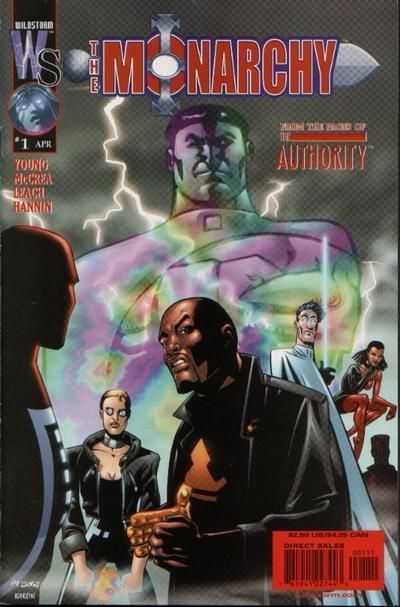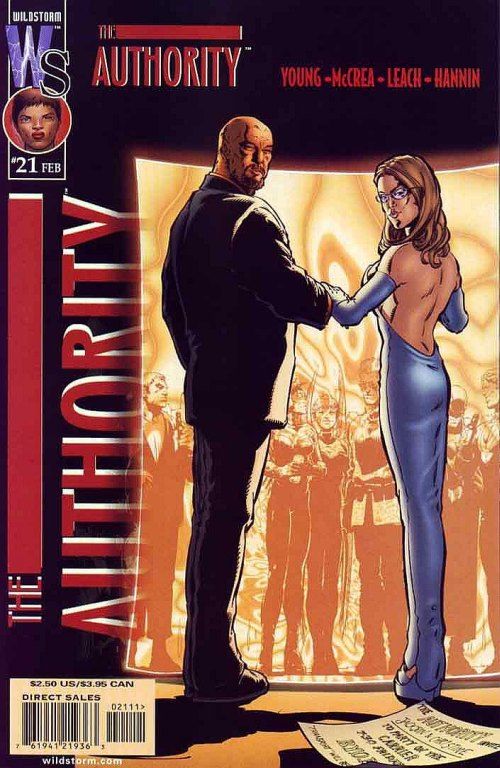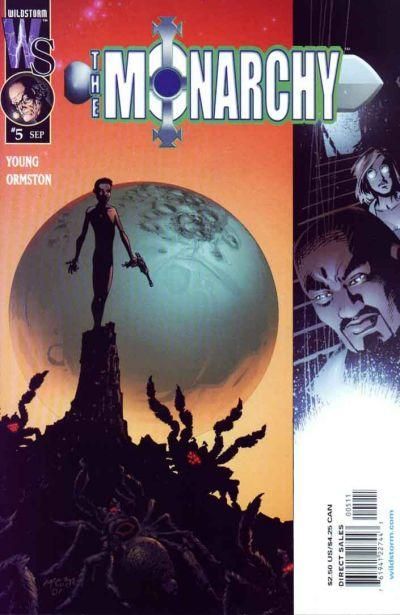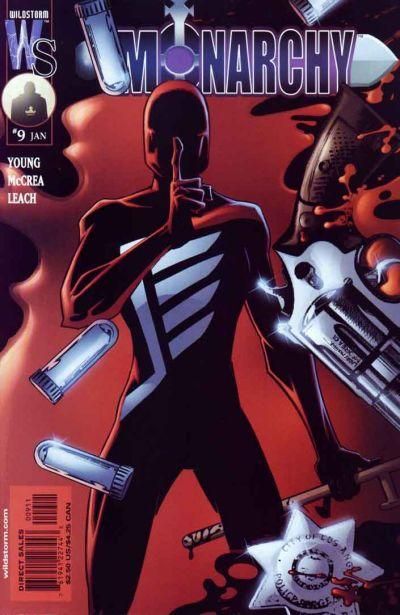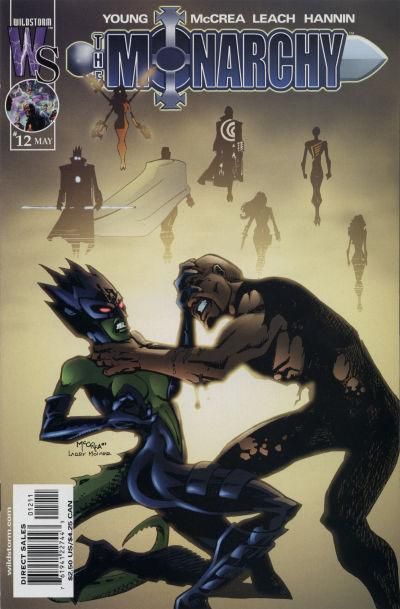With 52 behind us, we can press forward... or back to the early years of this decade when Wildstorm was home to some of the best comics being published by the big two. With so many to choose from, what book will I be rereading this week? More below the cut, including many, many spoilers.
The Monarchy #1-12 (plus The Authority #21) by Doselle Young, John McCrea, and Gary Leach with Warren Pleece and Dean Ormston.
When I first got internet at home, one of the first places I visited often was the Wildstorm sub-forum of the DC message boards. First, it was the sub-forum for The Authority and, then, other spots like Wildcats, Planetary and The Monarchy. Like various boards at the time, The Monarchy boards was frequented by the writer of the title, Doselle Young, and quickly gained a very tight-knit community feel. I think it was already up and running when I started posting, but I fit in quickly. Doe would do Q&As after each issue and it was a nice place. I interviewed Doe once for my then-weekly column (on my own site) called “Shut Up and Listen,” and he was always very friendly. When the first trade for the series came out, Bullets over Babylon, I even got a thank you along with many others — and, when I asked if I could send him my copy to get autographed, he just sent me a brand new one, and I passed my copy on to a friend who’d never read the book. Not that any of this really tells you much about the series, but it does have a personal connection to me.
The Monarchy was a spin-off of The Authority, the first part of its story actually coming out as an issue of The Authority, which seems a smart enough way to get people interested — or, at least, ‘trick’ them into reading the first issue of a new series. The book stars Jackson King and his wife, Christine Trelane, formerly of Stormwatch, but the two also made appearances in The Authority where Warren Ellis established just how far they’d fallen along with Skywatch, and planted the seeds for the resentment that King would feel towards the Authority. King, before the Authority was created, was the Weatherman, the man in charge of Stormwatch, which was disbanded after it was infested with Aliens at the end of Ellis’s run on that book. The Authority was made up of people who used to work for him, but, now, he was just some guy who worked at the UN that they would contact if they needed something. You can see why he would be bitter and resentful. That’s where we pick up: with a world class telepath and former leader of the best superhuman strikeforce/global policing group to ever exist feeling sorry for himself and mad as hell at his former underlings who have replaced him with an even better group.
When the book was in its original run, I thoroughly enjoyed it. The Monarchy was quite unlike The Authority, taking a much different approach to the concept of superhumans and a group like this. It evolved these characters and the first twelve (thirteen, technically) issues told one big story that would set up the series as something unique. Of course, it was cancelled due to low sales, but that’s to be expected with a book like this. But, it was another example of Wildstorm being a place that took an adult, mature, intelligent approach to superhero stories, while not necessarily relying upon swearing and nudity to reach those ends.
Of course, that was then. What do I think now?
The Authority #21 is the beginning of this series and takes place during the party on board the Authority’s headquarters, the Carrier, during issue 13 of the title, just prior to the Doctor heading to Singapore to try and grab the new Spirit of the 21st Century. The issue focuses on King and Trelane, while also introducing other key players in the series: Union and Jon Farmer. Part of understanding this issue relies heavily on knowing what came before in Stormwatch and The Authority. If you’ll recall, The Authority #13 was the first issue of Mark Millar’s run on the book with Frank Quitely where the group began applying their ideas more directly on the world, going after dictators and affecting direct change upon the political landscape. It was a natural progression for the book Warren Ellis had written for twelve issues.
I’ve been trying to come up with a way to sum up what The Monarchy is about, to describe exactly what happens in those early issues, and all I can come up with is that the book was doomed to be cancelled. It was so obvious. This is an obtuse book that requires patience and dedication. It requires the reader to trust in Doselle Young and to do the extra work to meet him halfway. It was the anti-Authority in so many ways. When comics were going widescreen and KICKSPLODE!, The Monarchy was going to opposite way. Which actually makes perfect, refreshing sense for a spin-off series to do. What’s the point of doing another book exactly like the one it’s spinning off of? The Monarchy is a genuinely, fundamentally different book than The Authority.
The concept: reality has cancer and Jackson King has a plan to cut that cancer out. These issues see him gather the right people and weapons to do so. We learn at the end of the series that the cause for this cancer is heavy traffic in the Bleed (the artery between realities) by the Carrier. Somehow, this has created a tumour reality that threatens to kill everything else. In a way, The Monarchy was a pre-emptive strike against the influence of The Authority.
“When the last time anything post-modern had a happy ending?” Agent Morro, The Monarchy #2
That quote seems rather central to The Monarchy. I know, I know, I know, “Oh god, this is about postmodern superheroes?” you all moan, but shut it. Because this is a postmodern story with a happy ending. It’s almost like that statement is a personal challenge that Young throws down. Superhero stories always have happy endings, so why not postmodern superhero stories? Then again, it’s only happy on the surface, because I’m convinced that the way in which is the first issue opens is the true end to this story, to this group.
We open on destruction in C-Space, the home of the Throne, a shiftship that houses a group of superhumans led by King One. They’ve suffered massive loses, we see the bottom of a foot that’s almost certainly Jack Hawksmoor’s... we see what has to be the body of Noh-Varr in one of those little Easter eggs that we all love... the only survivors are King One, an older, thicker Jackson King, and Morningstar, ‘the Prince of Light,’ and ward of King One aka Jon Farmer. The Throne has been destroyed by Abraham Dusk, a traitor to the group, a living bacterium. In the final moments, King One sends Morningstar through the Bleed to a lower reality while destroying their reality to contain Dusk.
In early 2001, Jackson King and Christine Trelane underwent apotheosis on board the Carrier, and walked away with a mission. Union killed himself aboard the Carrier that night, too. You all remember Union, some shitty mid-‘90s superhero that no one remembers. Jon Farmer was the bartender that night and he walked away unimpressed with King. Now, King wants him to join his group, and Farmer thinks he’s insane. Meanwhile, a little kid named Matt was on a school bus when it got into an accident that resulted with him having radioactive control rods sticking out of his chest and the ability to give others powers, which his ‘friends’ have taken advantage of to become a junior high version of the Authority, killing crack dealers, and treating Matt as a living battery until he talks back, and they decide to beat the living shit out of him. Farmer is a priest in Philadelphia. He says no to King’s invitation several times, but the crisis involving Matt convinces him otherwise. Oh, and there’s a Persian woman named Professor Q.
That doesn’t actually tell you much, does it?
The Monarchy is ambitious and a failure as a series for a lot of reasons. Doselle Young really tries to put these characters, old and new, in situations quite unlike what they’d face in other books. We receive little explanation for anything or how it fits together until the final issues. What happened aboard the Carrier? What changed for King and Trelane? When King talks about this group acting as surgeons for reality, what does he mean? Union has returned as a skinny, trench-coat wearing sociopath, but King wants Farmer to save his soul. Who is Professor Q? Oh Christ, I don’t know what to tell you. I’m trying to lay shit out so that when I discuss it, your eyes glaze over a little less than they would otherwise. This isn’t the sort of book where that’s easy. I’ll continue to try, so forgive me for failing — and for making these little apologies.
There are two glaring problems with The Monarchy: the writing and the art. I don’t see the writing as a problem really, because it is the sort that appeals to me. I love something that’s challenging and requires me to fill in blanks and actually makes me think about what I’m reading (and not in a “Why the fuck did I waste my money on this shit?” sort of way). But, that’s not for everyone and I recognise this. As I’ve said, Doselle Young really goes for the slow burn, for a subtle storytelling that requires you to wait until issue twelve for everything you’ve read to pay off. This is the sort of book designed to shed readers, particularly those looking for Authority style widescreen violence.
The art is a much easier to pinpoint problem and one that I continually butted my head against in this reread. John McCrea is not a bad artist, he just is not the guy you want drawing a subtle, serious postmodern superhero book. He does funny well, he does slapstick, and caricature. His work is cartoony and inconsistent. I’m really enjoying him on Herogasm right now, but this book required someone different, someone receptive to and in tune with Young’s writing. The only issue of this book that works visually is the fifth issue, illustrated by Dean Ormston where his darker, moodier art matches up with Doe’s writing very well. The Monarchy suffers quite a bit because of McCrea’s art — and I’m not saying that to attack him or his work, it’s just that it’s not the right art for the title. In some places, he knocks it out of the park, but those instances are rare, three or four panels an issue. At most. And that’s not good enough. If only three or four panels in any given issue are working with the writing, are communicating 100% what they should, you need a different artist. And I know that this was an issue for some behind the scenes at the time, and for readers as well. But, Wildstorm was committed to McCrea. He isn’t that bad here, just ill suited.
If there is one single issue that works on every level, it's issue five, "The Boy Who Talked to Spiders," starring a young Henry Bendix in Maladyville, Mississippi as we learn that maybe he wasn't so evil. Maybe everything happens for a reason. Maybe he's always known what the plan is and he made sacrifices to save the world. I'm sure there are some who don't like that Young turned Bendix back into a hero in The Monarchy, but he does it so effortlessly by showing young Bendix as a young boy and a science fiction hero already. He goes to another world in his closet with giant talking spiders that sometimes look like people where he's known as Lieutenant 'Happy' Hank Bendix. His father killed his mother and may do the same thing to his step-mother. As Jackson King puts it, in the present, as he and Christine look through Bendix's childhood home, "My god. Ten years old and already making plans for the Midnighter and worse." Young doesn't just redeem Bendix, he completely transforms the character, putting everything you've ever read in a new light... at one point, Bendix learns to tow the dragline and sees his entire life. He sees everything. And he accepts it. At ten years old, he writes the journal entry that narrates the issue to King. He addresses him directly, because he knows he will be the one who finds it.
Young is at his most focused here and paired with Ormston, this issue sings. I actually own two copies of this issue: one that I bought to complete my run and an autographed copy (weird how the few comics I have that are autographed keep coming up) that I got... somehow. I don't know how. Something to do with the message board. It is, by far, the best issue of the series. It also hints at how good this book could have been if Young were paired with the right artist. Ormston's art is moody and dark and haunting. It just clicks with Young's writing. Is it wrong that if I were a billionaire, I would hire Ormston to go back and draw the other 12 issues just so I could read this run that way?
Issue five is also the prelude to the book's biggest arc, "Making the Metropolitan," a story that's a little too bloated for its own good, but sets up the final three-issue story rather well. It features the first direct confrontation with the Chimera, the main enemies of the book, the beings on the tumour world. It also features the death of Jackson King, an event that was rather shocking since, up until that point, King was the motherfucking man. It stems from an effort to turn a loser superhero into a badass supervillain by placing the Native American god of Los Angeles in his head. Really.
Lost Angel is the loser superhero and a rather nice character, very Spider-Man-esque. He can't pay his bills, his girlfriend dumps him via answering machine, unable to deal with his nighttime hobby, and he's really just a skinny nobody who got powers in an accident. In Bram's case, his powers seem to be the ability to get the shit kicked out of him, get up, and run home. And, thanks to the notebooks of Henry Bendix, King has a plan to turn him into the supervillain they need him to be, the Metropolitan (featured on the cover of issue nine at left). It's an interesting idea, but not executed terribly well. The actual transformation is a mismash of psychic manipulation that's too obviously symbolic and, as always, vague hints as to what's going on. Ultimately, the plan succeeds, but not before the Serpent god destroys King's mind, killing him. That really was a big surprise and comes rather abruptly at the end of issue eight. The ramifications almost destroy the team as they wonder how they can proceed.
The arc is very quite bloated and has a lot of scenes, like the rest of the series, that come across as filler, never quite delivering anything of real substance. Rereading it, I couldn't help but think that it could have been made two issues without losing anything of great importance. In one scene, Christine calls her grandma for no apparent reason since, immediately after convincing her grandma that she's alive, she has to get off the phone. I still can't figure out what that's all about. Why would she call after several years when she can only talk for two minutes? The pacing is way off in this series and this four-issue story (with a prologue issue added on!) demonstrates that clearly. We never get a real sense of what Bram transforms into at the end, which is another weakness. Since Young is building up to the big reveal of how it all fits together, he never stops and provides any ideas about these characters at that moment. It's all shunted to the final issues and that's some piss-poor storytelling. You can't have a four-issue story that's called "Making the Metropolitan" and never deliver any real information on what the Metropolitan is by the end. Well, you can, but it's shit like that that gets books cancelled after driving readers away. I love that Young is Doing It His Way and all, unwilling to pander, but he doesn't break the rules with enough skill or style to justify doing so. Nor does he exhibit enough ambition in the process. And, I'll tell you right now, the payoff for the Metropolitan isn't big enough to warrant this cop-out, but I'll get to that shortly.
This arc does feature on the few chances we get to see the team engage in Official Superhero Activity as they fight the Chimera military. It almost seems out of place in this book for the characters to... use superpowers to fight bad guys. Jon Farmer stands out at the only true superhero of the bunch and its his role in the group. Young is very mindful of what each character's role is -- and, as I said, even when he reveals said role, the revelation isn't always worth it.
"The Idiot's Guide to the Death of the World" is the final story of The Monarchy and takes up the final three issues. It is the story that ties it all together, revealing what happened on the Carrier and what this group that King has assembled is meant to do. Young goes for a very ominous mood and McCrea never quite delivers. In issue 10, there is actually one godawful page that's not McCrea's fault, but that of computer colouring. Farmer looks up at the night sky and it's cracked, the Bleed seen in the cracks, and it just looks so bad, so laugh-out-loud ugly and wrong. That one page almost sums up the art of the book since McCrea's drawing of Farmer isn't that good either.
In the final story, the Monarchy (if we're to call the team that) go up against the Higher Power, the Chimera's version of the Authority. Yes, it all comes full circle as Jackson King's group fights against, basically, the Authority! Because the Authority is bad! Oh ho ho!
It all gets pulled together, too, as Malcolm King (complete with the Kheran Dreaming Engine from issue two) arrives with Agent Morro (complete with the blueprint in his head, planted there by Jackson), and they hook up with Adie Vochs -- or, Vox, while the rest fight the Higher Power, who have destroyed Kansas and seemingly killed Farmer off panel. the Metropolitan is the one thing that can kill the Chimeran Jack Hawksmoor. That's all he does.
Jackson King returns from the dead as a fictional being after adult Henry Bendix resurrects him. Yes, Bendix is back, because death is the last part of the iniation into the group. They're all working for the spiders (or, Weavers), who recruited King and Trelane back on the Carrier that night to save the entire structure of reality from the tumour growing in the Bleed. King reforms Farmer as a sword and kills Mistress Midnighter (leader of the Higher Power) and Fenris, the 'puppy' they exchanged for Hitler's soul back in issue three eats the world.
Yeah.
Everyone serves a purpose, but it's so specific that one wonders how the group could have continued after this story. The story is narrated by Christine as she tells it to Matthew (from issue one -- the kid) and recruits him. At the end of the issue, they stand on the moon (not the moon you're thinking of) and look at the Throne, the new base of operations. This ending convinces me that this group will end where King One's group ended at the beginning of the series. Obviously, King's group here would have to expand with each missions since the members are so specialised and Matthew will clearly become the new Jon Farmer. Oh, and did I mention that the Metropolitan/Lost Angel's name is Bram... or, should I say, Abraham Dusk? The traitor from the first issue? The hero they turned into a villain? Oh ho ho!
So, while this postmodern tale has a superficially happy ending, the seeds are there to suggest that it's a recurring loop of events and this group is destined to die, the reality they inhabit sacrificed with their youngest member sent out to a lower reality to save it perhaps.
Overall, The Monarchy is a worthwhile read. It suffers from Young's attempts to work against the then-current trends in comics and, as a result, really work against a lot of storytelling methods that would have improved the book greatly. I do admire that it is a year-long build-up to that final issue where everything is revealed... except that the revelation isn't as big as it needs to be. It's all sort of "Oh. That's it?" The Monarchy never delivers that knock-out punch and you can't blame it on Young not having enough space to tell his story since a lot of what we get is filler -- or reads as such at least. Tightened, this could have been a really great six to eight issue story instead of a 13-issue drag.
In issue 11, Young hints at what the book is all about with Christine talking about how it's about stories and how they work, how they fit together, and you can see that as Young references Greek myths, other superhero comics, sci-fi pulps, and numerous other things to try and create a cohesive whole... but it doesn't work. There's far too little commentary that gets through and the plot isn't engaging enough to truly keep the reader hooked. The Monarchy tries to be a bit too much of everything, while also trying to be itself completely, and winds up not working really.
I began this post with a much more positive opinion of the book, but in talking it through, I can see things a bit more clearly (which is how these posts almost always go). I still think it's a worthwhile book and one you should track down, if only because it tried to be different.


